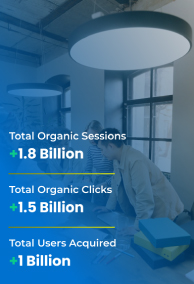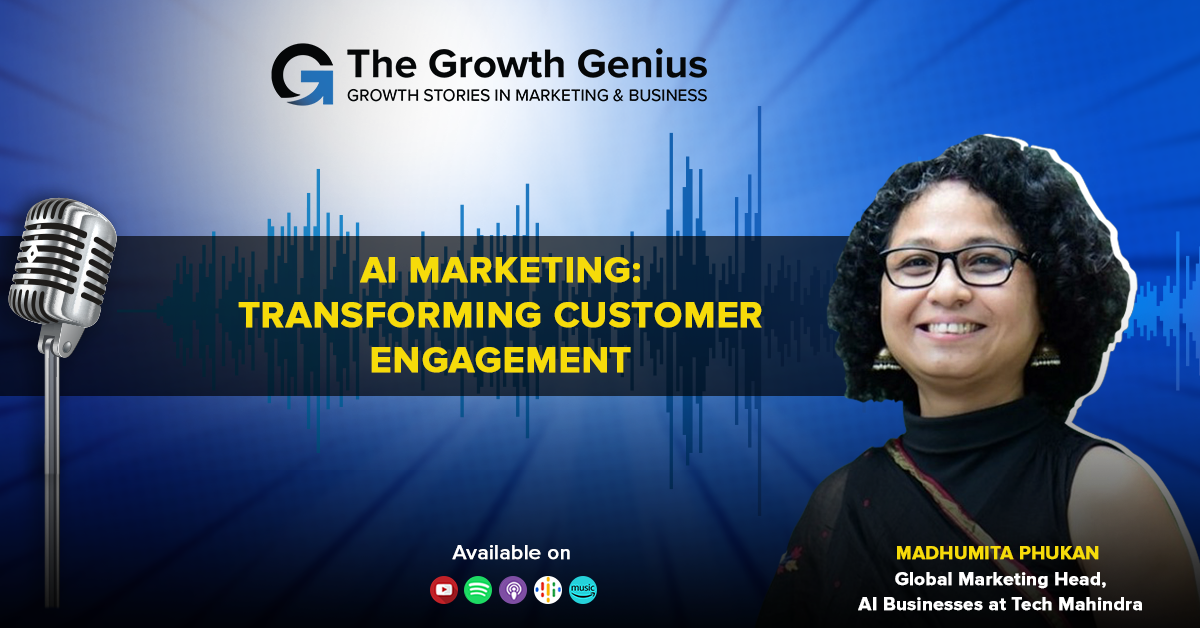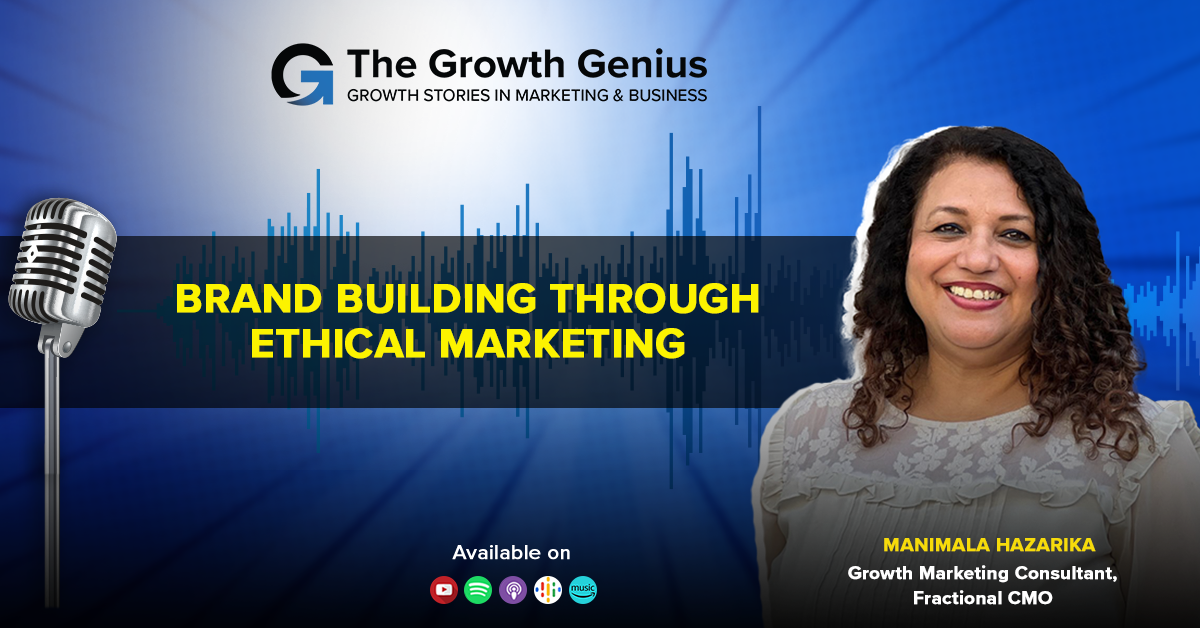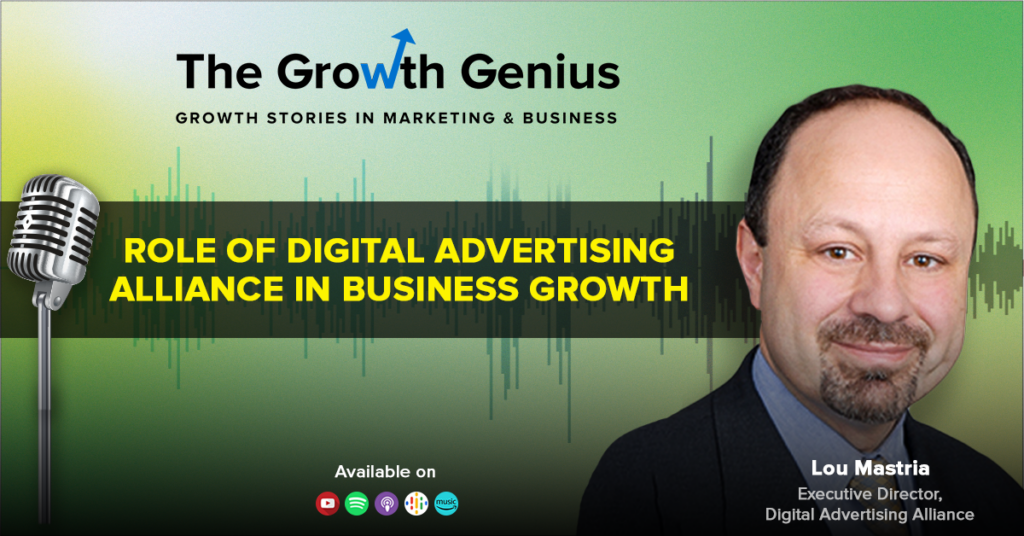
Witness an Increase in your ROI
Unlock higher rankings, quality traffic, and amplified conversions through tailored award-winning SEO strategies.
Listen on your Podcast app
Summary
The Digital Advertising Alliance (DAA) plays a crucial role in the growth of businesses through its focus on digital advertising. In a podcast episode, the DAA discusses the importance of self-regulation and consumer privacy in the digital advertising industry. They emphasize the need for transparency and choice in data collection and usage, as well as the significance of responsible advertising practices. The DAA also highlights the benefits of its AdChoices program, which allows consumers to control their online advertising experience. By promoting ethical and responsible digital advertising practices, the DAA contributes to the growth and success of businesses in the digital landscape.
Key Take Aways
8 Key Takeaways for a Digital Marketer from this Blog:
- Understanding the Role: The Digital Advertising Alliance (DAA) plays a crucial role in promoting responsible advertising practices and consumer privacy protection.
- Self-Regulation: The DAA encourages self-regulation among advertisers, ensuring they adhere to ethical standards and guidelines.
- Adherence to Privacy Principles: Digital marketers should prioritize consumer privacy by following the DAA’s privacy principles, such as transparency and choice.
- Enhanced User Experience: By implementing DAA guidelines, digital marketers can provide a better user experience by delivering relevant and personalized ads.
- Trust and Credibility: Adhering to DAA standards helps build trust and credibility among consumers, leading to increased brand loyalty and customer retention.
- Compliance with Regulations: Following DAA guidelines ensures compliance with various privacy regulations, reducing the risk of legal issues and penalties.
- Cross-Device Tracking: Digital marketers can leverage the DAA’s guidelines to effectively track and target consumers across multiple devices, enhancing campaign effectiveness.
- Industry Collaboration: The DAA promotes collaboration among industry stakeholders, allowing digital marketers to stay updated on the latest trends and best practices.
Overall, digital marketers should recognize the importance of the DAA in promoting responsible advertising practices, protecting consumer privacy, and enhancing the overall effectiveness of their campaigns.
Read Transcript
Lou Mastria:- So whether you wanted to use a cookie, a mobile ad ID, a hash email, a hash phone number, a probabilistic ID, whatever you come up with could be subject under the AMI framework. One of the foundational elements of the Ad Choices program has been that consumers see the Ad Choices icon and associate it with trust and a better consumer experience. There will be a way for brands and publishers to communicate to consumers through an icon-based solution where they can effectively prompt it.
Shelly Singh:- Hello, everyone. Welcome to The Growth Genius series, brought to you by DMAasia and Infidigit. My name is Shelly, and I’m the Country Director – Americas at Infidigit. I’m also the Founder and Director at DMAasia. My guest is Lou Mastria, Executive Director of the Digital Advertising Alliance. He leads the US and global efforts for self-regulation, consumer transparency, and choice in delivering interest-based advertising online. A hot welcome, Lou.
Lou:- Shelly, thank you very much for the kind words. I look forward to a great conversation.
Shelly:- Great! Tell us a little about your DAA journey, how it started and what has been achieved so far.
Lou:- Thanks. That’s a grand opening. So DAA was founded in 2008-09 by the leading trade associations representing the digital advertising industry in the United States. And that included the brand side marketers through our board member, the Association of National Advertisers. The agencies through the forays the publishers through IAB at that time, DMA US, which represented many of the marketers and the ad tech community. And then later on, two other organizations joined us: the NAI, which focuses on ad tech, and the American Advertising Federation, which also focuses on agencies. And the growth was astounding because, in some ways, we were asking companies to commit and up-level their privacy standards. And so there was significant uncertainty as to whether that would work. But the reality is that many companies were looking for a tool, a solution set that allowed them to do that work in a way that respected the fact that they also have businesses. And so a way to balance privacy as well as their business needs so that they can continue to give consumers what they want while at the same time being respectful of their privacy. And so where we are today is many years later, as we’ve delivered the Ad Choices icon now at rates of over a trillion times a month globally. We are in 36 countries in 28 languages. As one publisher told us, we are easily the most published element on the web. And so that didn’t happen because I’m here or because DAA is excellent. However, it is because of the investment companies made in their brand equity to deal with consumer privacy concerns proactively.
Shelly:- Great. That’s great. So my next question is that in the cookie-less future, how relevant is the DAA program now, and what are your new initiatives?
Lou:- It’s a good question that many marketers are thinking about today, for sure, Shelly. The reality is that DAA’s principles are purposely made to be technology neutral. And so we never had to worry about the change, for example, from cookie to probabilistic IDs, because our principles applied equally in both cases, nor did we have to worry about the change from cookies to mobile ad IDs. Again, the principles apply. And so, as we look at a future that has, whether it’s hashed emails, hashed phone numbers, or some other new identity type, it doesn’t matter. The self-same responsible set of practices, guidelines and guardrails, really, for privacy, will be able to apply in those areas as well. And so recently, we’ve undertaken a broad review of where we stand, where the market stands in terms of its ability to apply these to a new area. We’ve developed some new certifications to help marketers address those needs in the future. Whether that future is a cookie or not is immaterial to us. What is essential is that there are guardrails about that future, which fall under a rubric called the Addressable Media Identifier Framework. And that framework will guard not only what a brand does but also its equity and its relationship, the special relationship it has with its consumers. Because it looks forward and says, it doesn’t matter what the technology, I’m going to either use this data in a permitted way or if it’s prohibited, I will not collect or use it in that area. And so those are two fundamental shifts in the way that the industry approaches consumers. It is backed up by more than a decade of independent enforcement through DAA and a robust certification process through our partners at Trust.
Shelly:- So besides cookies, what are other types of AMI in use nowadays?
Lou:- The beauty of the AMI structure is, again, we followed our technology-neutral mandate. We didn’t care. So whether you wanted to use a cookie, a mobile ad ID, a hashed email, a hashed phone number, or a probabilistic ID, whatever you come up with could be subject to the AMI framework. It could be tested under the AMI framework and proven to be inside. So an AMI certified AMI or not? And so for brands, this is an easy way to solve a lot of the new terminology and jargon that’s coming out regarding Identifiers to ask, are you a DAA-AMI certified Identifier or not? And if you are, we could give you some additional privileges. If you’re not, we may ask you to get certified through this industry-standard process.
Shelly:- So you were talking about the policy framework. What does the AMI policies framework entail, and where is this being deployed?
Lou:- So what it entails most specifically is, number one, there’s a certification, a third-party certification that happens right at the outset for the Identifier. And so if a company subjects itself to that, that’s a reasonably strenuous level of rigor that it puts itself under. If it passes that, it is allowed to go into the market and say it is an AMI-certified Identifier. In doing so, what it promises, what that company is promising, is that things like permitted uses are allowed, prohibited uses are put to the side and not allowed. And then there’s a middle tier of uses permitted only in an opt-in environment. There are other parts of the framework that deal with differing legislative and regulatory requirements and different geographies. So a multinational company could quickly adopt the AMI framework. And so, for a brand that needs to enhance its audience and find the largest audience possible, you can use the opt-out framework in the opt-out environment. For a brand that, for regulatory or legislative reasons or its marketing reasons, chooses only to use opted-in audiences, they can do that as well. And the AMI certification looks at that in advance. And so, a company that has been certified is not allowed to go to market and market itself as an AMI framework unless it has a way to differentiate between those opt-in and opt-out audiences. And so that is a real part of the novelty brought to the market from this framework. And what a brand gets from the fact that DAA is pushing this is that there’s a standard; there’s one way to do this. And so you, as a brand, can be sure that it is being applied equally to all the companies responding to your RFP. Now, we are first rolling this out in the US. But we are looking to see how it adopts and how much traction it gets here in the States. And as it does that, we will look to other markets. This is very similar to how we rolled out the Ad choices icon back in the day and some of the other tools we’ve rolled out over time.
Shelly:- That’s great. So how soon will certified AMIs be in the ad tech marketplace?
Lou:- The very first one will be in the market before the end of the year, so that we will look for a few more right after that. But don’t forget, this is a significant step we’re asking Identifier companies to take. And so, I wouldn’t be surprised if it’s slow going for a bit, but in 23, we will see a few more companies come to the market. But we’ll be able to get one through the process before the end of the year.
Shelly:- So, who do you think are the early adopters of certified AMIs? Can you name any companies?
Lou:- I could, and then I could be fired. What you’ll see, and we’ve seen this already in some of our early conversations, is that the identity provider market has been growing. Now, it’s not huge, not in the hundreds, but it’s probably in the 50 to 100 number somewhere in there. And we have seen some interest from a good number of folks in that market, particularly the leaders, the big companies in that space. And those, no surprise, are the first ones to raise their hands. But again, because there is an independent third-party certification, the path from raising my hand to doing it is a bit fraught, and for this purpose, we want to make sure that these companies know what they’re doing, eyes wide open. So you’ll see the Identifier market company start first. But what we’re seeing, and this is a little bit of a surprise to us, a pleasant surprise, was that as we were talking to brands and we were talking to publishers, they were asking what they can do to support this. Now, that’s an unusual request because this is, after all, a voluntary standard. But they see value for their customers in having a standardized framework. And so what they’re asking is how can I go into the market and vet my vendors with this framework in mind? And so we’ve seen several publishers and brands come back to us and say, OK, so what can I put in my RFPs? What can I put in my T’s and C’s such that I give some privilege, some account for the fact that an Identifier company may have taken this massive step in consumer privacy?
Shelly:- This is an excellent self-regulatory initiative, but how does it work in regulated environments like GDPR DMA, DSA in Europe, NCCPA in the States and Canada, Pip, etc.? So how will this work in those environments?
Lou:- Yeah, that’s a great question. And indeed, one of the things that we wrestled with a great deal as we were bringing this to market was that for many years, and I think you know that the DAAs would look at particular markets and try to function just within that market with this framework. We did look at places outside the US. Outside the typical areas that we look at. Part of that was that the group of companies and organizations that helped influence and lend input to this did come from beyond the US. There were three to 400 companies in total and organizations that contributed to this. And many of those are multinationals, and many were from outside the US. And so that input meant that we had to create a framework that allowed for opt-in and opt-out environments, and so the AMI framework does allow for that. And so, when we test, does your Identifier support the framework? We’re looking for tests that do both. Do you have an opt-in audience? We can see that you have an opt-out audience. And do you have controls in place for those things? And so that’s how we tend to approach that.
Shelly:- Hey, if I’m a brand or publisher and would be a user of AMIs, what should I be doing to ensure the addressable media solutions I’m using conform to these industry privacy structures and expectations?
Lou:- So that’s pretty easy right now. We’ll come back with some additional guidance but with more specific guidance for each group, publisher and brand. But I think right now what you can do is ask your identity provider, say, hey, look, we’ve heard about this AMI framework. We’re interested. We were hoping you could talk to us about how you see this, how you’re either applying this framework or why you have chosen not to apply it and start that conversation. Because it’s early days and we certainly have put a push into the market, and we have had some companies already start their initial attestation stage. It does need market demand. And so if you’re a brand, if you’re a publisher, and you know that your future will rely increasingly upon protective privacy standards, this one is perfect for you to be launching some of those initiatives inside your organizations by bringing in identity providers who have themselves gone through a fairly rigorous certification process.
Shelly:- What does this addressability mean to the consumer? Will this help brands gain customer trust?
Lou:- Absolutely. One of the foundational elements of the Ad Choices program has been that consumers see the Ad Choices icon and associate it with trust, associate with a better consumer experience. And so, as we look at the AMI framework, we see a path to that in brands and publishers adopting that and showing that off to consumers. Part of the idea here is that there will be a way for brands and publishers to communicate to consumers through an icon-based solution where they can effectively trumpet the fact that they are doing vendor vetting based on this framework and that their suppliers are going through this framework before becoming embedded with them. And so for a consumer who wants relevant messaging, the right message at the right time, for the right relevance, who wants the ad-supported and subsidized internet. This means that they will not only continue to have choices about how these things work, but they will also inherit some of the safeguards built into the AMI framework. And that is a potent tool, mainly because the consumer doesn’t have to do anything; they get it as soon as the brand or publisher they work with allows an AMI-certified identity provider to go through. That means that that website, app, or device suddenly has all those safeguards built into it. Now, I will say this too. On the choice side, the consumer will also get additional options. So, for example, today, as you know, we support cookie-based choice, and we support mobile Ad ID-based choice. But we’ve recently launched a hashed email ID-based choice. And so that will be coming out there. We’ve also launched a category-based choice platform for consumers. And so consumers can go in and tell companies, hey, look, I don’t want to get the dating ads, or I just bought a car, please don’t send me the car ads, et cetera, et cetera And so all of this is being made possible by frameworks like AMI.
Shelly:- While you told me that this is initially a US-focused program, do you think there will be a global application for such certified AMIs?
Lou:- Absolutely. That’s part of the plan. We’re starting to roll it out in the US. Only because we had the infrastructure to start here first, but any of the DAA programs today could start to roll it out in their jurisdictions as soon as they’re ready. Some are more ready than others. Some have other issues that they’re dealing with. So there’s a little bit of it’s going to be a little bit of a stair step, but at the end of the day, this will be a global program.
Shelly:- Wow, this is a great initiative, Lou. More countries will follow in their footsteps to launch this program for their brands and consumers. Now to our last segment. Tell us about any passion you follow and how it helps elevate your profession.
Lou:- I hate talking about myself, but the one thing that I like to do a lot, and I’ve been lucky enough to do with a lot of industry colleagues, is I like to cycle. And everything from taking tours to just doing 15-20 miles with several colleagues and peers or even spin classes with some colleagues and peers. It’s been a great way not only to form and reinforce the necessary bonds in an industry like ours. But it’s also been instructive in terms of mental focus and the necessary persistence that is part of how to succeed in such a dynamic industry. As you know, Shelly, things change day in and day out in the digital ad ecosystem. And so being able to look at the long road ahead of you and know that that’s where you’re going, regardless of cross-cutting traffic, impediments in the road, regardless of the hill that you might have to climb. That has been a terrific way to spend my off time with colleagues and peers, bringing some outstanding lessons to what I do for a living. And I enjoyed it for those reasons. Thank you for asking that.
Shelly:- That’s a great passion. So how can our viewers reach you and connect with you? How can they follow you?
Lou:- If you have to email me, I’m at [email protected]. If you want anything about DAA, go to digital advertising alliance.org. If you want to follow us, I think we are @DAAusa. Well, you can find me on LinkedIn. You can also find me in other places, but those are the primary channels.
Shelly:- Thank you so much, Lou. It was a very informative conversation. To everyone who is watching this show, please SUBSCRIBE to this channel. Also, watch out this space for the next episode of The Growth Genius Season. Till then, peace.
Popular Searches
Technical SEO Audit Services | Google Penalty Recovery | Local SEO Service Provider | Amazon PPC Services | Enterprise SEO Consultant | Best Ecommerce SEO Company | ASO Services | Content Marketing Services | Conversion Rate Optimization Services | What is Google AdWords | What is Google Analytics | Google Ranking Factors | SEO Tools | What is Google Tag Manager
How useful was this post?
0 / 5. 0











